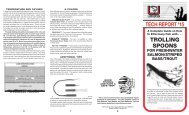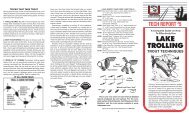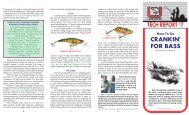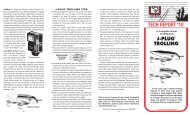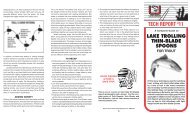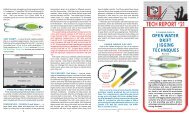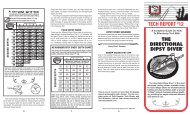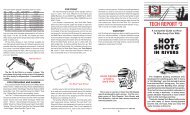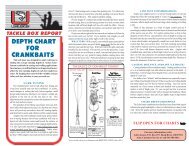Create successful ePaper yourself
Turn your PDF publications into a flip-book with our unique Google optimized e-Paper software.
through erratic troll patterns or rod pump ing. Ex am ples includetrolling in a circle around vertical structure holding fish, slow rodpumping on a slow troll, or speed-trolling on a zigzag course. Allof these patterns cause the lure to in ter mit tent ly fall and flutteras if you were jigging. The most pro duc tive universal size is the1- or 1 1/2-oz. Crippled Herring. On a smaller scale, the 1/6-oz.Crip pled Herring is very ef fec tive for trout and kokanee. Tip:The Glo finish is the first choice for early mornings and darkdays. Once the bite stops on Glo, change to Pearl white orChrome (for bright days). This color ar range ment is a con sis tentpro duc er for salmon. For trout, use Gold and for kokanee, Red/Pearl white is top choice.NEAR-SURFACE FLATLINING: Especially with hand-heldrods, this is the most exciting form of trolling. As with all trolledCrippled Herring, adding a wil low leaf blade at trac tor to the tailincreases strikes. Up grad ing to a larger hook will not im pair itsaction when trolling. The lure should not skip on the sur facebut should run within 10 feet of it. For maximum pro duc tiv i ty,constantly pump your hand-held rod sidewise (all oth er nontrollingtech niques require vertical rod lifts) to max i mize thestrike-triggering back ward flut ter. For most species, speed willvary between 1 1/2 and 5 mph (e.g. about 2 1/2 mph for cohosalm on and up to 7 and 10 mph for wahoo). Don't troll blindly!Troll under diving birds, through bait fish "ball-ups" and on thefringe of "boiling" fish. Under these conditions the action canbe nonstop.ROTATING FLASHERS: Attaching a 1-oz. Crip pled Her ring, 18to 24 inches behind the flasher is highly effective off a flatlineor down rig ger (a longer leader results in a slower action). Thiscombination will outfish flies, plastic squid and natural bait.DODGERS: Rig the same as for flash ers. Troll faster for cohosalmon and slower, and deeper, for chinook salmon.DOWNRIGGERS: water clar i ty and target spe cies de ter minetroll ing speed, leader length and lure size. Use the 1/6-oz. sizefor kokanee and trout, the 1- or 1 1/2-oz. for most species andthe 5-oz. for an oversize presentation.we hope these basic tips will pro vide a spring board to expanding your fishing knowledge and techniques for fishing theCrip pled Herring. Your success with this lure is directly proportionalto your un der stand ing of its mechanics, water con di tionsand fish be hav ior. Prac tice with your Crippled Herring in calm,clear water to become familiar with its variety of built-in actions.Once proficient, you literally will be able to pro duc tive ly "fish theworld".GENERAL IN FOR MA TION1. HOOK FILES: "Sticky-sharp" hooks dra mat i cal ly in creaseyour hook ups! A good test is to slide the hook point over yourthumbnail. If it sticks, it's sharp. Dull hooks slide off. LuhrJens en's fine-tooth file is ex cel lent for sharpening hooks (andfillet knives) in seconds.2. HOOKS: A single hook is stron ger than a treble. It is alsoused to reduce fish mortality and to min i mize snags and foul ingwhen fishing rocks and weeds. However, a fine wire treble hookis recommended when jigging for light-bit ing spe cies such asyel low perch and crap pie. Also, for ice jigging, you can replacethe single hook with fine wire treble hooks on both the nose andtail eyelets.3. SCENT: Under most con di tions, fish strike the Crip pled Herringin re ac tion to its ap pear ance and sonic vi bra tions. Adding baitis not rec om mend ed, especially for the small est size lures, sincethis would impair their delicate balance and action. Ex cep tions:a) Tip lure with minnows when ice-jigging. b) when fish ing isslow, tip with a piece of night crawl er for walleyes, and squidor cutbait for salt wa ter spe cies such as grouper and snap per.Synthetic at trac ta nts include Smelly Jelly , Berk ley's ® PowerBait ® liquid scents and Berkley's Crappie Nibbles ® for crappie.4. LURE SIZE: Generally use the smallest lure to ef fec tive lyreach the fish. Small lures catch big fish, es pe cial ly when thefish are not active.5. SNAPS & SWIVELS: Attaching a snap swivel directly to theCrippled Herring is not recommended unless when trolling orusing the Don Iovino technique of "swimming the spoon". TheCrippled Herring is the favorite lure for bass pros such as "Hallof Famers" Don Iovino and Kevin VanDam. (Don jigs it with alift-shake-drop rod action over break lines.) The best combinationis to attach a wide bend snap or tie a loop knot to the lureend of the leader with a swivel on the opposite end if line twistis a problem. This also prevents killing the lure's action causedby tying di rect ly to a smaller lure over load ed with heavy shockleader. Tying directly to the lure is fine as long as you matchlight line to light lures.Note: when casting or vertical jigging, with Berkley FireLine ® ,it is not nec es sary to use a swivel since there is no problemwith line twist.6. ATTRACTORS: Attaching a willow leaf blade to the back ofthe hook can increase strikes, especially on the retrieve and whentrolling. This presentation will out-fish most other speed-trollingtechniques in salt wa ter! Best size is a 1- or 1 1/2-oz. CrippledHerring. Use a snap (not a snap swivel) to attach the blade tothe split ring. The blade should not extend beyond the bend ofthe hook. Fluorescent Char treuse works best on dark days andbright Nickel on sunny days.7. LEADER: Fluorocarbon or clear monofilament is best whencutoffs by sharp teeth are not a problem. Oth er wise, use singleor multi-strand dark wire and swiv els. Use longer and thinnerdiameter leader in clearer water.8. MAIN LINE: No-stretch, braided "superline" (e.g. BerkleyFireLine) is best for longer casts, better hook-sets, min i miz ingline drag and for tele graph ing strikes, especially in deeper water.when jigging, no-stretch main line is far superior to monofil a mentand does not readily twist.<strong>9.</strong> <strong>RODS</strong>: The general rule is, "the larger the jig, the greater therod strength required to effectively fish the jig". for im provedhook sets when jigging, use shorter rods with strong backboneand a fast action tip. Quality graphite rods are best for lightweight, sen si tiv i ty and strength. G. Loomis ® and Rogue rodsare top choices.Spinning equipment is pri ma ri ly used in shallower wa ter, whencasting to surface-feeding fish or when troll ing. I per son al lyfish 5-ft. med.-light, and 6 1/2-ft. light, fast action rods spooledwith 6- to 8-lb. FireLine when casting 1/6- & 1/4-oz. lures. For1/3- to 1-oz. lures, I use a 5 1/2- to 6-ft. med-heavy to heavyspin ning rod with 10- to 14-lb. Fire Line. when trolling for largeFlor i da Gulf spe cies, a 1 1/2-oz Chrome Crip pled Herring isfished on a 7-ft. med-heavy spin ning rod with 20-lb. FireLine.Sur f cast ing re quires longer spin ning rods for great er dis tance.A bait cast ing outfit is used for jig ging in deeper water. Ideal forhandling 3/4- to 3-oz. Crip pled Herring is a 6 1/2-ft. heavy G.Loomis MBR 785 IMX rod with 20-lb. FireLine. Heavi er, but notlong er rods are used for heavier lures.10. Lures cast on tight or heavi er lines sink more slowly thanon slack line (better results for sus pend ed fish.)11. "MATCH THE HATCH": At times it is critical to match lurecolors with the colors of the bait fish in addition to matching thesize of the baitfish being eaten (ex am ine stom ach con tents ifnec es sary).12. DON'T FISH OUT OF CONTROL: Poor con di tions in cludemuddy water, strong tides and ex treme ly high or low baro met ricpres sure (fish deep er on higher read ings). Avoid any weathersituation that com pro mis es line control and, most im por tant ly,your safety. To rem e dy a bow in your line, cast di rect ly up ordown wind."Our fish resources are fragile and need our help. Practice"<strong>Catch</strong> & Release" while the fish remains in the water. Avoidhandling fish with dry hands, towels and coarse mesh landingnets. Thank you for your stew ard ship and for fishing the Crip pledHerring."Captain Pete Rosko, Designer/DeveloperThis is one of a series of more than 25 detailed reportspro duced by Luhr-Jensen. For the com plete series ofTech Reports, Tech Sheets and Tech Bulletins, visit theLuhr-Jensen website at www.luhrjensen.com.Visit us on the web at www.luhrjensen.com #8822-024TECH REPORT # 24A Complete Guide on HowTo Effectively <strong>Fish</strong> with . . .THECRIPPLEDHERRINGU.S. PATENT 4631854REGISTERED TRADEMARK#1,861,032Some people are born fishermen.Pete Rosko is one of them. Morethan a fish er man, he is a perpetualstudent of na ture. His curiosityof creatures beneath the wa tersspawned the invention of theCrippled Herring lure. Originallycre at ed for salmon and halibutjigging, this bait-shaped metal jighas attracted the at ten tion of allPete Roskotypes of fish worldwide. It is themost versatile lure you'll ever use.Nat u ral in appearance and action, a Crip pled herring canbe used world wide, every day of the year, for all baitfisheatingpredator fish, in fresh and salt water.(Revised)© Luhr Jensen & Sons, Inc.678#24 Crippled Herring.indd 1 1/9/09 12:18:16 PM
A Crippled Herring is a sight-sound lure programmed to takeadvantage of the strong, natural predator instinct common toall gamefish. Every movement of any type of distressed baitfish(stunned, struggling or dying) has been engineered into it. It canbe cast, jigged through ice or in open water, or trolled. Manytimes a Crippled Herring will arouse fish and provoke strikeswhen conventional lures or natural bait will not.A prime example is a dead calm, bright sunny day whenfish seek bottom in deeper water. Predator fish will frequentlyswim past healthy baitfish to attack one in distress. An injuredbaitfish is an easy meal closely imitated by a Crippled Herringon its downward fall. Under most conditions, between 3 and300 feet of water, an angler proficient with a Crippled Herring willconsistently catch more fish. Almost all strikes will occur duringor at the end of the downward fall. The lift or forward movementof the lure attracts fish, but it is the backward or downward fallcreated by SLACK LINE that triggers strikes! Immediately reelin all slack line then set the hook, if the lure is "bumped", the linegoes slack during the fall, or if any resistance is felt. On SLACKLINE the Crippled Herring flutters, darts, wobbles and flashes likea stunned baitfish, creating fish-attracting sonic vibrations.Every Crippled Herring comes from the factory shaped foroptimum action and sound. The 1/6- through 5-oz. series isdesigned for lively action and is highly effective throughout theentire water column. Every strike-triggering action possible isprogrammed into each lure, making adjustments unnecessary.However, a "C" bend will cause the lure to fall slower on a morevertical path. An "S" bend will cause the lure to fall slower on amore horizontal path. Caution: Bending may result in fracture.TIME PROVEN TIPS1. DON'T FISH BLINDLY: Before fishing, use a quality electronicfishfinder to locate concentrations of baitfish or gamefish.2. LOCATE ACTIVE GAMEFISH: Look for diving birds and"disturbed" water caused by swirling, boiling or leaping fish.3. LOCATE FISH-ATTRACTING STRUCTURES & OPPORTU-NITIES such as underwater reefs, springs, wrecks, rock piles,submerged islands, pinnacles and ledges. Also, saltwater kelpedges, weed edges, floating debris, floating weed lines, rivermouths, river channel edges, tide or current breaks, clean waternext to dirty water, flood-lit areas, bridge abutments next todeep water channels, docks next to deep water, drop-offs nearpoints of land, standing timber, warm water discharges andthermoclines. Tip: You will hook many more fish, such as bassand snook, by vertical jigging off the dock or bridge vs. castingto these structures. Reason: Most of these fish position themselvesunderneath the protective structure and will not come outof its shadow to chase a lure that falls through the strike zone.In comparison, only vertical jigging constantly maintains thelure in this critical strike zone which often provokes instinctivestrikes.4. Match lure finishes to light and water conditions (forboth fresh & salt water): a) Clean water on bright days: Chromeor Gold. b) Clean water on dark days: Glo, pearl white or pearlwhite combinations. c) Dirty or tea-stained water: gold or pearlwhite combinations. d) Deep or dark clean water: pearl whitewith a fluorescent chartreuse "back". e) Under artificial light inclean water: Gold, Chrome or pearl white. f) Green algae-tintedwater: Gold, Fire Tiger or Pearl white or chrome with green"back". g) At ice-out: pearl white. h) Water with perch forage:Gold or Fire Tiger. i) Water with trout forage: Gold or RainbowTrout. j) All other baitfish forage (the following basic finishesshould be included in the tacklebox of every serious angler):Gold, Chrome and Pearl White combinations.Crippled Herring Smash Flash: The ultra holographicfinishes within the Crippled Herring Smash Flash selectionprovide superior realism in the most challenging clear waterenvironments. Color-matched to the most prevalent baitfish insalt and freshwater alike, Crippled Herring Smash Flash will foolpredators in the most selective feeding situations. Choose fromfive sizes in 1/2- to 3-ounce weights.JIGGINGAlways use a vertical, and not sideways, rod lift when vertical orhorizontal jigging. The vertical rod lift causes the lure to wobbleupward and positions it for the critical downward fluttering actionas the rod is dropped back toward the lure. The upward wobbleattracts fish but it is the downward flutter, imitating an injuredbaitfish, that triggers strikes. Almost all strikes will occur duringand at the end of the downward fall. Vary the length and speedof your rod lifts between 7 and 11 o'clock, until a successfulpattern is developed. Abrupt rod lifts (jerking) will attract fish.However, this may cause the lure to foul and will create excessiveslack line. Excessive slack line makes strike detection and hooksets almost impossible. (An exception is "weed line ripping" toinitially attract fish, then settling in with a more deliberate jiggingmotion with controlled slack line.) Many strikes will be disguisedas taps, slack line or a steady pull. If in doubt, rapidly reel inall slack line, then strike quickly.VERTICAL JIGGING: This is the most thorough and precise ofall techniques for suspended and bottom-positioned fish froma stationary position or during a slow drift. It is superior to allother techniques since the lure constantly remains in the strikezone. Only vertical jigging effectively permits reaching fish ininaccessible locations such as timber, weed or kelp pockets,floating debris, docks, piers and bridge pilings. For maximumcontrol, bait casting rods with levelwind reels are critical to effectivelyvertical jig to suspended or bottom-positioned fish inwater deeper than 60 feet. Before jigging to suspended fish,determine the amount of line released from your reel after thelevelwind guide moves from one side to the other. You will nowbe able to accurately drop your lure to where the fish are locatedby using the revolutions of the levelwind reel as your depth guide.Constantly monitor your electronic fish locator to remain overthe fish. This is a deadly technique, especially for suspendedfish such as salmon, kokanee, cold water largemouth bassand striped bass. When jigging for bottom-positioned fish,maintain a bouncing action against the bottom structure. Thisnot only keeps your lure in the strike zone it also triggers strikesas a result of the lure's sound against bottom and the puffs ofdebris it kicks up. Once your line angles off, speed-retrieve yourlure. At times this will trigger strikes as the lure passes througha zone of suspended fish.ICE JIGGING: Use the lightest lure and line to reach your target.The Crippled Herring can be used as the primary lure or as anattractor using the same presentations. (See Luhr Jensen's TechSheet "588 "Panfish on Hard Water"). Adding fine wire treblehooks to the nose and tail eyelets increases effectiveness with theprimary lure. Tip both hooks with small minnows, thin belly stripsor fish eyes. When fish are near bottom, occasionally bounceyour lure against the bottom to kick up silt to attract fish. Thenbarely work your lure a few inches above bottom. Strikes willoccur while it is pausing after very short lifts or twitches. Hold therod stationary 2 to 10 seconds after a lift or twitch, then repeat.Constantly monitor your fish locator for the precise position ofthe fish. For an attractor lure, remove all hooks from the lureand add a 2 1/4-inch, 4-lb. fluorocarbon dropper line to the taileyelet tipped with the lure/bait of your choice.HORIZONTAL JIGGING (Jig casting): This technique has awide variety of applications involving both baitcasting and spinningequipment from a stationary position or while drifting. It willeffectively cover water depths of 3 to 250 feet. Spinning tackleis best when targeting surface-feeding fish and down to depthsof 60 ft. Beyond 60 ft. baitcasting tackle is best but spinningtackle still can be used. Surface-feeding fish . . . for explosivestrikes, cast a 3/4- or 1-oz. lure and speed-retrieve after a 3 to5 count. When casting (or spinning) to suspended fish, engagethe reel once the lure hits the water and use a slow pumping rodmotion as the lure falls on tight line. This results in a slower fallrate with increased sideways action and sonic vibrations. Thisis deadly in a school of suspended fish such as king mackerel,salmon, striped bass or yellowfin tuna. Once the lure has almostsettled, speed-retrieve it back through the suspended fish. Attimes this will result in a savage strike.Casting to fish near the bottom (e.g. halibut, lingcod, grouperor snapper) over a snag-free bottom can be very effective atanchor or while drifting. At anchor, on a running tide, cast intothe tide and bottom-bounce the lure back to you. In calmerwater, cast in any direction. On a slow drift, in shallow water,casting directly into or against the drift can be equally effective.On a faster drift in shallower water, or any drift in deep water,always cast directly into the drift. This increases the amount oftime the lure can be jigged against bottom. Remember to fishwith controlled slack line.Notes: a) In shallower, snag-filled waters cast ahead (notsideways) into the direction of your boat's drift. Retrieve bybottom-bouncing the lure through the structure (rock piles andreefs are great). Since your lure reaches the target before theboat, fish are not easily spooked. Also, any snagged lure iseasily retrieved as the boat drifts over the snag. This is especiallydeadly when fishing for walleyes! Remember to use theSMALLEST lure that still permits you to make an effective cast.b) <strong>Fish</strong>ing out of a rod holder can be very effective, in a chopof 1 to 2 feet, for vertically-bouncing your lure along a smoothbottom for species such as halibut, grouper and walleyes . . .equally effective at anchor or slow drift."DEAD STICKING"This is a very simple, exciting and unbelievably effective techniqueto catch large fish on light spinning tackle. Basically, the reelis engaged as soon as the cast lure hits the water. The lure ispermitted to free-fall while maintaining a stationary (dead stick)rod position of about 8 to 10 o'clock. In effect, the built-in actionof the Crippled Herring does all the work. It closely resemblesthe natural action of a crippled or stunned baitfish.Use the smallest lure possible since it's important for it to fallslowly. (During saltwater tests, many chinook salmon over 20-lbs. were caught on 1/6- and 1/4-oz. Crippled Herring in 15 to40 feet of water using 8-lb. no-stretch FireLine. Strikes variedfrom light ticks to savage hits.) The important combination forsuccess is heavy concentrations of baitfish and active fish.This is also a technique in which slack line will not result in manymissed strikes; the minimal resistance of the smallest lures donot alert the fish that it just ambushed an artificial baitfish. Asa result, the fish will often hook itself as it makes its run. "Deadsticking" is especially effective next to shoreline structures suchas kelp and weed bed points and pockets, islands, rip rap andwalls. Wind and current drive baitfish concentrations againstthese structures, which in turn attract predator fish. Once thelure reaches bottom in shallower water, try jigging it back to you.Otherwise, speed-retrieve and repeat your cast.DEPTH CHARTUnder calm conditions, the maximum effective depths for verticaljigging with monofilament line are:1/6-oz. to 15 ft. 1/4-oz. to 25 ft. 1/3-oz. to 35 ft.1/2-oz. to 45 ft. 3/4-oz. to 55 ft. 1-oz. to 70 ft.1 1/2-oz. to 90 ft. 2-oz. to 120 ft. 3-oz. to 140 ft.4-oz. to 160 ft. 5-oz. to 170 ftTROLLINGThe Crippled Herring can be used with all trolling techniquesincluding flat lining, planer boards, planers and downriggers.Use it whenever you would use spoons. Unlike spoons, whichtroll in a fairly tight pattern, the Crippled Herring has a morefrantic action with a pronounced sideways kick to either side.This erratic change in action triggers strikes. Use high qualityball bearing swivels to prevent line twist. Whether slow or speedtrolling, do not run in a straight line or at a constant speed.Strikes dramatically increase by changing the action of your lure2 3 4 5#24 Crippled Herring.indd 2 1/9/09 12:18:16 PM



